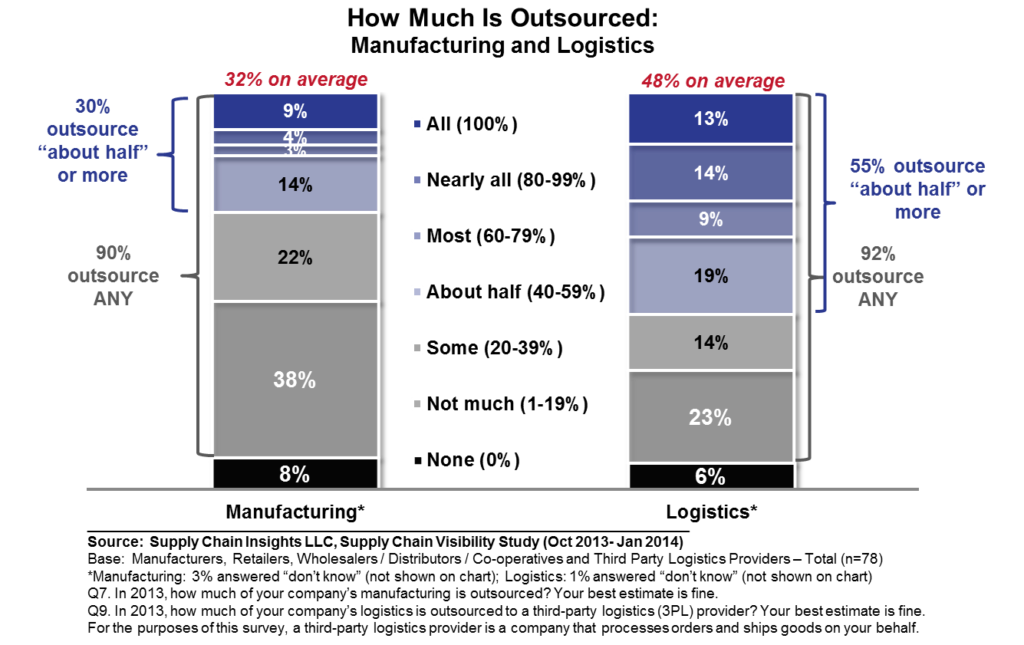 Today’s supply chain is inside-out. Companies wait and process orders. They cannot sense and respond to demand. It is a struggle. The processes are largely batch and out of cadence with the markets they serve. Increasingly, business requirements are outside-in. The channels are multi-tier and companies are more dependent on outsourcing.
Today’s supply chain is inside-out. Companies wait and process orders. They cannot sense and respond to demand. It is a struggle. The processes are largely batch and out of cadence with the markets they serve. Increasingly, business requirements are outside-in. The channels are multi-tier and companies are more dependent on outsourcing.
Systems are growing more complex. Yet, the primary means to manage trade with network partners is through spreadsheets and email. It is inadequate.
To solve this problem we wanted to “spark” a different conversation. It is for this reason that we hosted our first session on building the Network of Networks. At the meeting last week we explored the options to build a network of networks. At this session we wanted to brainstorm together–supply chain leaders with technology visionaries. The goal? How to drive interoperability between solutions that automate the extended supply chain.
Twenty-six business leaders attended our first session. When we opened the discussion, supply chain leaders checked-in by sharing their current thoughts. In the words of the supply chain leaders:
- “I think that this meeting is the Davos of supply chain thinking. I am impressed with the people in the room.”
- “Lora, you force us to look ahead. While we want to stay very rooted in fundamentals, however this does not get us to where we need to go. Events like this help me to shift from thinking from the day-to-day.”
- “Our enterprise systems are harder to use than those in our personal lives and we do not know what to do about it. We are stuck in trying to fix the fundamentals in systems that are tough to use that are only focused on making the enterprise more efficient. It is hard for us to find time to have a different kind of conversation. That is what I am hoping to have today…”
- “Lora you make my head hurt, but it is a good thing. We should be having this type of meeting more often.”
- “It is hard for me stay current on technology. I feel very inadequate. I am hoping to learn something new. Excuse me if I don’t use the right terminology.”
- “I struggle to buy technology. All vendors sound the same. I am hoping to leave here with a clearer vision of the technology options.”
Why the Discussion on the Network of Networks?
This discussion on the Network of Networks started at our Supply Chain Insights Global Summit last fall. We had published five pieces of research on the state of supply chain visibility and there were many questions on the evolution of Supply Chain Operating Networks. (A Supply Chain Operating Network is a many-to-many architecture which allows many companies to connect to many companies through multi-tier relationships. These flows are bidirectional with a system of record between trading partners. The Supply Chain Operating Network currently manages approximately 7% of value network commerce; however, the evolution of this technology category is still very immature.) The group voiced complaints that there is no interoperability between networks. The integration between Elemica to GT Nexus to SupplyOn to E2open requires specialized, custom code. With Infor’s acquisition of GT Nexus, SAP’s acquisition of Ariba, and E2open’s acquisition of Terra Technology, it has grown more confusing for the business user.
Looking Back at History
When I was a Gartner analyst in 2001, I tracked over 400 trading exchanges. The market of Supply Chain Operating Networks consolidated. When I was an analyst at AMR Research in 2007, I tracked 30. Today there are a handful.
The evolution is very industry-specific. There are more viable options for industrial value chains than customer-centric value chains. There are currently no good solutions for consumer products or food/beverage.
A decade ago the vision of value network solutions was limited by technology evolution. The visions of companies like i2 Technologies’ Tradematrix were ahead of what was possible with technology. This is no longer the case. With cloud-based analytics, non-relational database open source code sharing, and advancements in predictive, prescriptive and cognitive analytics, what is old can become new again. It is now possible to connect networks in new and meaningful ways.
One of the drivers, as shown in Figure 1, is the current level of outsourcing. The level of outsourcing is larger and more important. Today’s spreadsheets, emails, and faxes, along with manual processes, are used to manage inter-enterprise business management. This does not allow bidirectional collaboration, and a multi-tier system of record. It also does not allow for the deployment of community-based analytics to test and learn.
Figure 1. Current State of Outsourcing

What is clear from the discussion is ERP is not the backbone for the value network. While it is clear that ERP is the backbone, and system of record, for the enterprise, this is not the case for the value network (multi-tier communication and supply chain process coordination.) As shown in Figure 2, there are three primary ways to digitize trading partner relationships. Hadoop is changing the face of Value-Added Networks and the Supply Chain Operating Networks are adding community-based services.
Figure 2. Inter-enterprise Connectivity

Insights on Building the Network of Networks
As we discussed the evolution of the Network of Networks concept it was clear we have more questions than answers. It is also clear that today we can forge new solutions. Companies are ready to embrace the velocity of data and the need for agility. As we talked we evolved a set of principles.
The Principles:
- Time. Not all data needs to fly first class. While many companies speak to us about the need for real-time data, we believe that data needs to move at the “right timing.” Some data needs to move quickly and with high velocity using streaming data architectures, while other data sources can move in batch processes.
- Embrace Glass Boxes. While traditional processes are powered by black boxes, the principle is to build the network of networks using glass boxes. With a glass box the math is visible to the super-user. The goal is to let the math engines do the work and not touch data.
- Test/Tune and Then Embrace Analytics. However, to evolve the network of networks, companies need to test and tune the analytics and then use them. What we often see is companies approaching the implementation of analytics as a technology project and missing the stages to test and tune.
- Digitize Relationships. Map Policies and Flows. The first step is onboarding and digitizing relationships. In this process, gain clarity of contract requirements and policy guidelines and try to incorporate them into the flows.
- Focus on What You Are Good At. Not all technology solutions are good at the same thing. The business users asked for the technology providers to be clearer on what they are good at and improve effective interoperability between solutions. While partnerships have not worked in the past, the question on the table is “Could we build new forms of interoperability using unstructured data on Hadoop, and map data using ontologies and indexing technologies?”
- Focus Outside-in. The goal is to move data outside-in and define new processes. The gluing together of existing processes is not sufficient.
- Externalize Data. If companies open up and externalize data in a meaningful way we could pave the way for online benchmarking, demand sensing, and event management in new ways.
- Takes Responsibility for Your Network. To make this work companies need to have a process owner to design the network with a focus on the roles of parties in the network, buffers, and policies.
- Open Standards. Pub/sub/keys. If the vendors could publish using open architecture principles, the barriers would be less.
- Build Bidirectional Flows with an Inter-Enterprise System of Record. Just as ERP is the system of record for the enterprise, there needs to be an inter-enterprise system of record.
When we got done with the two days of discussion we took a deep breath. At the next session we will showcase case studies of technology vendors partnering with business leaders to build these building blocks. Attendance will be invitation only. The goal is to keep the meeting small and engaging with a 50/50 split of business and technology leaders. We will keep you posted on our progress.
About Lora:
 Lora Cecere is the Founder of Supply Chain Insights. She is trying to redefine the industry analyst model to make it friendlier and more useful for supply chain leaders. Lora has written the books Supply Chain Metrics That Matter and Bricks Matter, and is currently working on her third book, Leadership Matters. She also actively blogs on her Supply Chain Insights website, at the Supply Chain Shaman blog, and for Forbes. When not writing or running her company, Lora is training for a triathlon, taking classes for her DBA degree in research, knitting and quilting for her new granddaughter, and doing tendu(s) and Dégagé (s) to dome her feet for pointe work at the ballet barre. Lora thinks thinks that we are never too old to learn.
Lora Cecere is the Founder of Supply Chain Insights. She is trying to redefine the industry analyst model to make it friendlier and more useful for supply chain leaders. Lora has written the books Supply Chain Metrics That Matter and Bricks Matter, and is currently working on her third book, Leadership Matters. She also actively blogs on her Supply Chain Insights website, at the Supply Chain Shaman blog, and for Forbes. When not writing or running her company, Lora is training for a triathlon, taking classes for her DBA degree in research, knitting and quilting for her new granddaughter, and doing tendu(s) and Dégagé (s) to dome her feet for pointe work at the ballet barre. Lora thinks thinks that we are never too old to learn.







